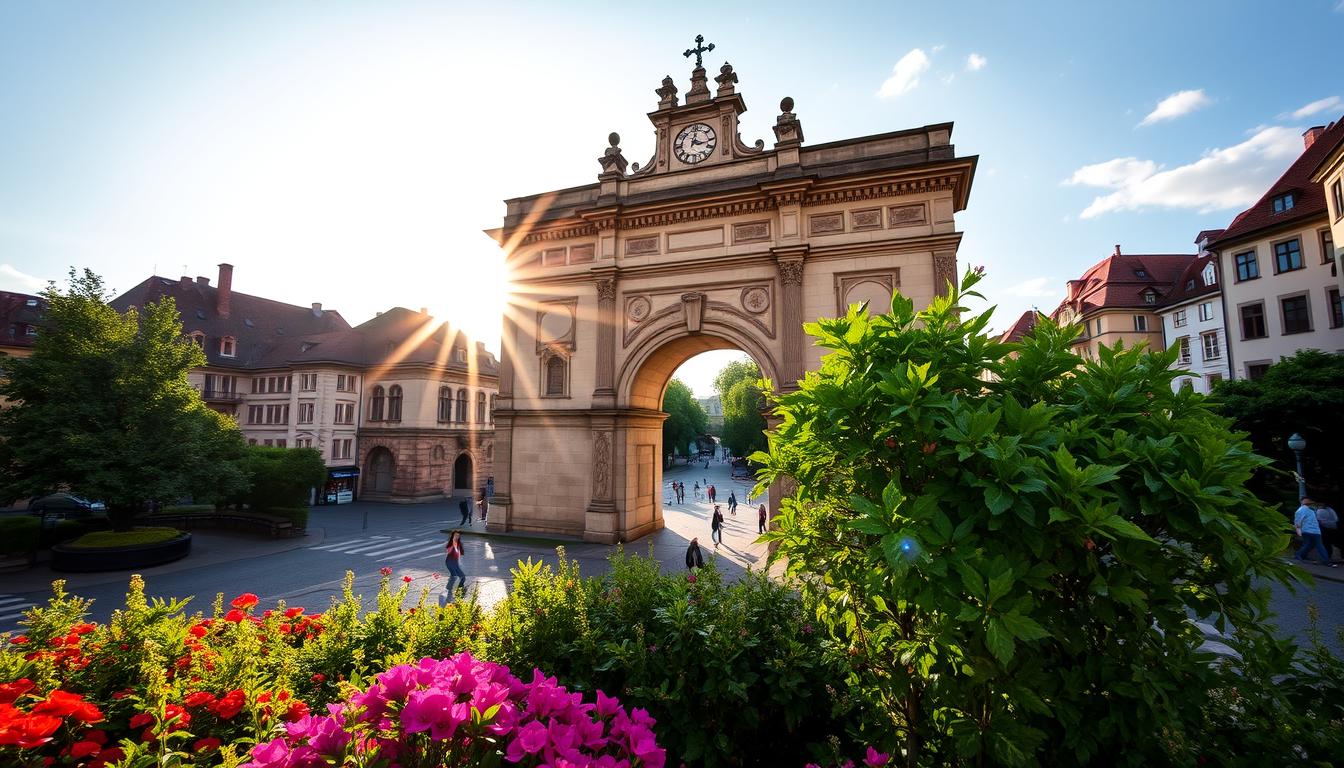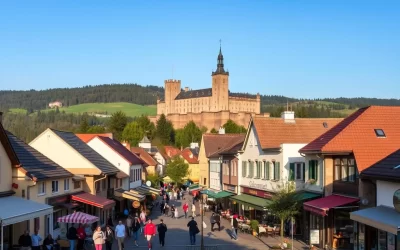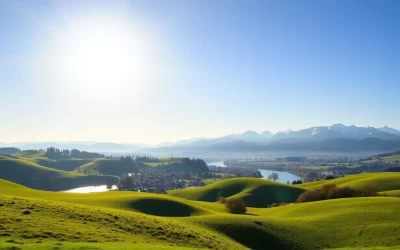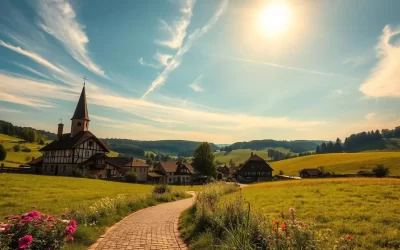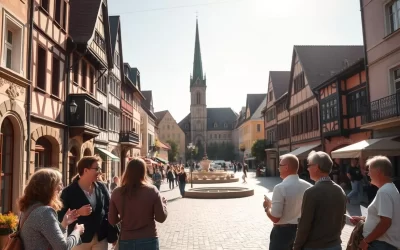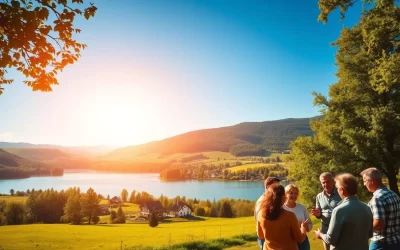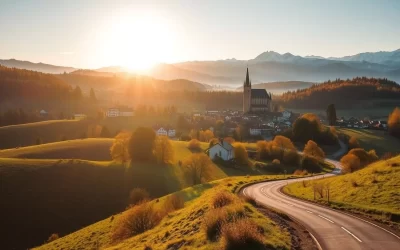Have you ever wondered about Germany’s oldest city? Trier is a place where ancient Roman history meets medieval charm. It’s a journey through time that you won’t forget. Located in the Moselle wine region, it offers a unique look into European history.
Trier is a treasure trove of history, dating back to the 4th century BC. It’s a city with Roman roots and stunning architecture. Whether you love history, culture, or adventure, Trier has something special for everyone.
Key Takeaways
- Discover Germany’s oldest city with over 2,000 years of history
- Explore world-class Roman architectural monuments
- Experience a UNESCO World Heritage site
- Immerse yourself in rich cultural and historical experiences
- Enjoy proximity to the beautiful Moselle wine region
- Visit multiple historical sites within a compact urban area
History of Trier: Germany’s Oldest City
Trier is in the heart of Germany and has a history over two thousand years old. It shows the growth of human civilization, from ancient Celtic and Roman times.
The city’s story is one of cultural change. Founded by Emperor Augustus in 17 BC, it became a key Roman center in western Europe. Let’s look at the key moments that made Trier special.
Celtic Origins and Roman Empire
The city started with Celtic tribes in the late 4th century BC. The Romans took over in 15 BC and named it Augusta Treverorum. They built a great city that was the Roman Empire’s western capital.
- Founded by Celts in late 4th century BC
- Conquered by Romans in 1st century BC
- Served as western Roman capital for 400 years
- Hosted at least eight Roman emperors
Medieval Development
When the Roman Empire fell, Trier kept its importance. It became a key place in medieval Europe, keeping its Roman past alive.
“Trier is not just a city, but a living museum of European civilization.” – Local Historian
Modern Era Significance
Today, Trier is a place where old history meets new culture. It has the most Roman buildings outside Rome and many UNESCO sites. Visitors get a unique look into the past here.
- Home to 8 UNESCO World Heritage Sites
- Birthplace of Karl Marx
- Strategically located near Luxembourg and France
Ancient Roman Heritage: Porta Nigra and City Gates
Step into the heart of Trier’s Roman legacy with the magnificent Porta Nigra. This city gate is a breathtaking testament to ancient architectural brilliance. It stands as the most impressive Roman ruins in Trier, captivating visitors from around the world.
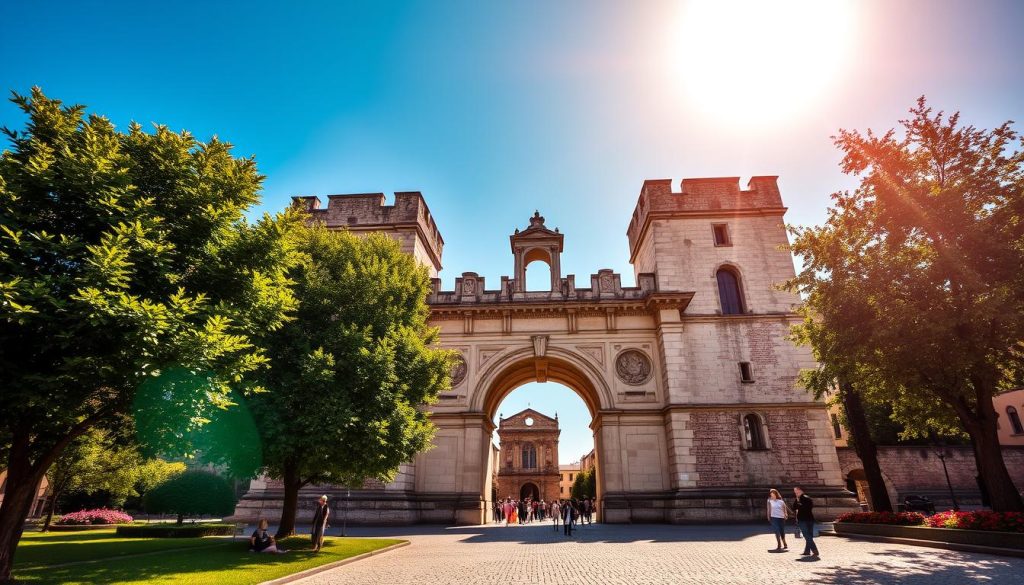
Erected around 180 AD, the Porta Nigra is an architectural marvel. It has survived centuries of history. Made from 7,200 gigantic sandstone blocks, this massive structure represents the pinnacle of Roman engineering in northern Europe.
Key Features of Porta Nigra:
- Largest preserved Roman city gate north of the Alps
- Four-story high defensive structure
- UNESCO World Heritage site
- Built during the reign of Emperor Marcus Aurelius
Exploring the Porta Nigra takes you back to the Roman Empire days. The gate’s name, “Black Gate” in Latin, comes from its dark patina. This patina has developed on its sandstone over centuries.
Roman Engineering Highlights:
| Feature | Specification |
|---|---|
| Construction Period | Around 180 AD |
| Number of Sandstone Blocks | 7,200 |
| Historical Significance | Primary defensive entrance to Roman Trier |
“In every stone of the Porta Nigra, you can hear the whispers of Roman legionaries and feel the pulse of ancient history.” – Local Trier Historian
Visitors to the Porta Nigra can enjoy guided tours. These tours bring the Roman ruins of Trier to life. You can walk through the same passages that Roman soldiers once defended.
Whether you’re a history enthusiast or a casual traveler, the Porta Nigra offers an unforgettable journey. It showcases the remarkable architectural and cultural heritage of Roman Trier.
Religious Architecture and Sacred Sites
Trier is a top spot for seeing sacred buildings. Walking through this old city, you’ll find amazing religious sites. These landmarks show how architecture and faith have changed over time.
The religious sites in Trier are truly awe-inspiring. They show the city’s deep spiritual history. These places are not just beautiful; they also hold a lot of history.
Trier Cathedral: A Spiritual Masterpiece
Trier Cathedral, also called St. Peter’s Dom, is a top example of religious architecture in Rhineland-Palatinate Germany. It was built in 326 AD, making it Germany’s oldest cathedral.
- Founded by Emperor Constantine
- Blend of Romanesque and Gothic architectural styles
- Houses significant sacred relics
Constantine’s Basilica: Roman Architectural Grandeur
The Aula Palatina, or Constantine’s Basilica, is the biggest Roman building left in the city. Today, it’s a Protestant church. It shows the amazing skills of ancient Roman builders.
“A testament to architectural brilliance that has survived millennia” – Local Historian
Medieval Church Exploration
Trier also has many medieval churches. These small churches tell stories of faith and creativity.
| Church Name | Architectural Period | Unique Feature |
|---|---|---|
| St. Gangolf Church | Gothic | Intricate stone carvings |
| Our Lady’s Church | Late Gothic | Stunning altar artwork |
Exploring Trier’s religious buildings is a journey through history. It shows the spiritual soul of this ancient city.
Roman Baths and Amphitheater Complex
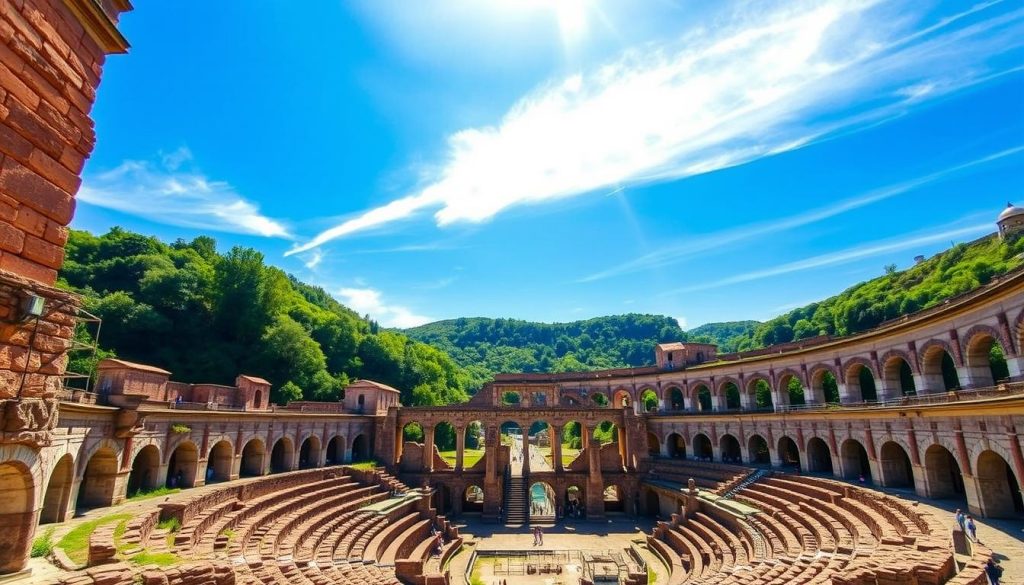
Step into the ancient world of Roman ruins Trier and discover incredible archaeological treasures. These treasures bring history to life. The city has some of the most remarkable Roman remnants north of the Alps.
The Barbara Baths show off Roman engineering and social culture. They cover 42,000 square meters, making them the second-largest in the Roman Empire. Citizens would gather here to socialize, relax, and enjoy the baths’ facilities in the 2nd and 5th centuries.
Highlights of Roman Architectural Marvels
- Barbara Baths: Second-largest Roman baths in the Empire
- Amphitheater: Capacity of 18,000 spectators
- Extensive underground tunnel systems
The Roman Amphitheater is just as fascinating. Built in the 1st century AD, it could hold up to 18,000 spectators. You can almost hear the roar of the crowd during gladiator battles and animal hunts that once entertained the residents of Augusta Treverorum.
“Walking through these Roman ruins Trier is like traveling back in time, where every stone tells a story of imperial grandeur.” – Archaeological Historian
| Roman Site | Construction Period | Notable Features |
|---|---|---|
| Barbara Baths | 2nd Century AD | 42,000 sq meters, Social Center |
| Amphitheater | 1st Century AD | 18,000 Spectator Capacity |
Admission to these historical sites is affordable. Tickets cost around €4 for adults and €2.50 for children. Whether you love history or just enjoy exploring, the Roman ruins Trier offer an unforgettable journey through time.
Trier, Germany: Best Things to Do – Top Picks
Explore Trier, a city where ancient history meets modern culture. It’s one of Germany’s oldest cities. Here, you’ll find historical sites, cultural experiences, and local fun that will amaze you.
Essential Historical Sites
Trier is a paradise for history lovers. Don’t miss these key spots:
- Porta Nigra: The largest Roman city gate in northern Italy
- Roman Amphitheatre: An ancient venue that once held 18,000 spectators
- Barbara Baths: Sprawling Roman public baths covering 42,000 square meters
- Basilica of Constantine: An architectural marvel with 33-meter high ceilings
Cultural Experiences
Dive into Trier’s cultural scene with these unique activities:
- Visit the Karl Marx House Museum
- Explore Trier Cathedral, Germany’s oldest bishop’s church
- Wander through the historic Hauptmarkt square
- Enjoy local Moselle Valley Riesling wine tastings
Local Entertainment
Trier has lots of fun for everyone. From Michelin-starred restaurants like Becker’s to cozy cafes, there’s plenty to do.
“Trier is not just a destination, it’s a journey through time.” – Local Travel Guide
The city center is small, making it easy to walk around. Spend at least a day to see all the historical and cultural wonders.
Karl Marx House and Cultural Heritage
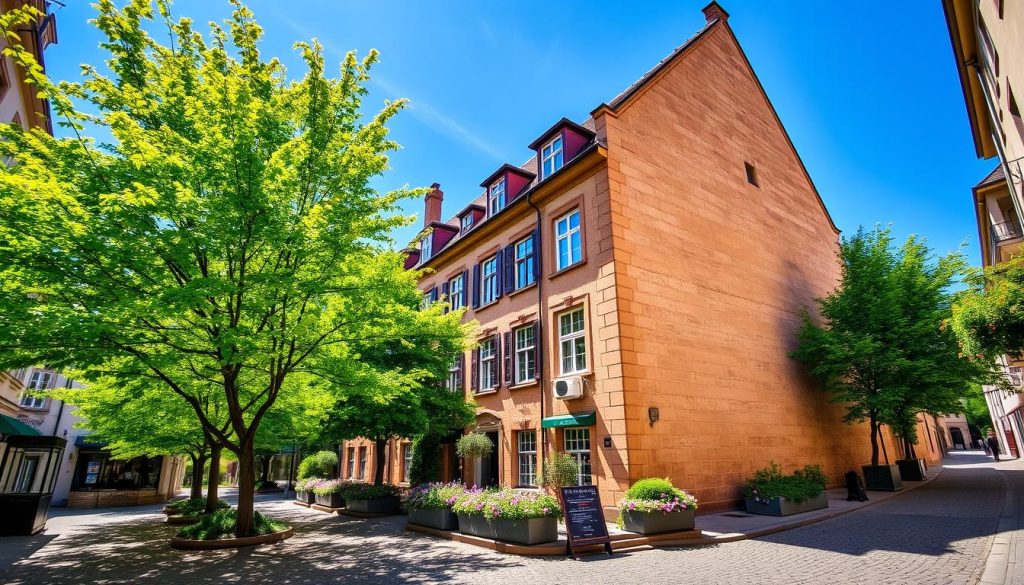
Explore the deep history of Trier, where Karl Marx was born. This city played a big role in shaping one of the most influential thinkers of our time. The Karl Marx House, at Brückengasse #10, shows where Marx’s journey began.
Visiting this museum takes you into Karl Marx’s world. You’ll see an 18th-century house that’s been kept just as it was. It gives a close look at Marx’s early years and his big impact on politics and economics.
Museum Highlights
- Original family artifacts and personal documents
- Interactive exhibits chronicling Marx’s life
- Comprehensive display of his philosophical works
- Multimedia presentations about his revolutionary ideas
The Karl Marx birthplace museum lets you see how Marx grew up in 19th-century Trier. Each exhibit shows how he went from a local thinker to a world-renowned intellectual.
“To change society, one must first understand its fundamental structures.” – Inspired by Karl Marx’s philosophy
Visitor Information
| Detail | Information |
|---|---|
| Location | Brückengasse #10, Trier, Germany |
| Year of Birth | 1818 |
| Museum Type | Historical Biography Museum |
| Recommended Visit Duration | 1-2 hours |
Make plans to visit this amazing Karl Marx birthplace. Dive into Trier’s rich cultural heritage. It’s a city that has shaped some of the world’s most influential thinkers.
Moselle River Experience and Wine Culture
Explore the magical world of the Moselle River, where wine, history, and nature blend. Trier’s spot on this beautiful river lets travelers dive into Germany’s most stunning wine area. The Romantic Rhine Valley shines through Moselle River cruises, highlighting the region’s wine history.
The Mosel wine region is a special place, with 8,743 hectares of vineyards and 60 million vines. It’s home to 3,000 winegrowers. What’s unique here is the terrain – over half the vineyards are on slopes over 30 degrees, with some as steep as 70 degrees.
River Cruises
Start an amazing journey on Moselle River cruises. You’ll see stunning views of vineyard-covered hills and quaint villages. The Mosel Cycle Path, from Trier to Koblenz, is 248 kilometers long. It’s a great way to see the area’s beauty.
Wine Tasting Tours
- Try famous Rieslings from 60 local wineries
- See 160 wine varieties at the Mosel Wein Museum
- Discover historic wine villages with old traditions
Riverside Activities
The Mosel region is perfect for those who love adventure. You can rent kayaks for about 34 euros a day to explore the river. The Moselsteig Trail is 400 kilometers long, with 24 sections for hikers of all levels.
“The Mosel Valley is not just a wine region; it’s a living testament to centuries of viticultural passion.” – Local Wine Expert
Whether you love wine or nature, the Moselle River offers a memorable trip through Germany’s most beautiful landscapes.
Hauptmarkt and Shopping Districts
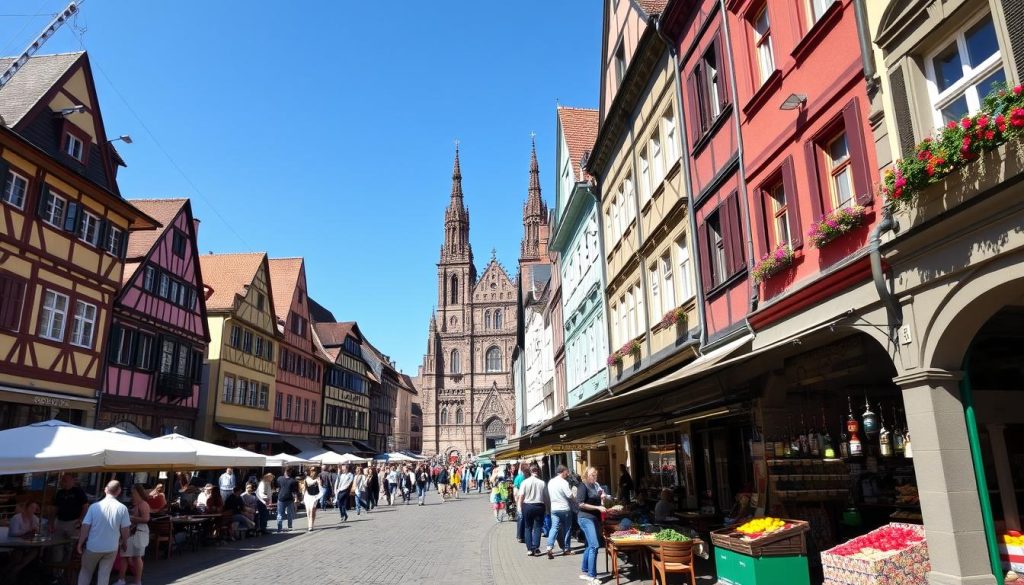
Explore the lively heart of Trier at the Hauptmarkt. This historic market has been the city’s center for centuries. It shows you the real local life and shopping.
The Hauptmarkt is more than a market. It’s a key part of Trier’s culture. With its half-timbered houses, it hosts weekly markets. Seasonal events make it even more magical, especially the Christmas market.
- Weekly local produce markets
- Seasonal special events
- Historic architectural surroundings
- Local artisan and craft vendors
Be sure to see the Dreikönigenhaus (House of the Three Magi). It’s a historic building turned cozy café. It adds beauty to the Hauptmarkt and is great for a break.
“The Hauptmarkt is where Trier’s heart beats, connecting history with modern daily life.” – Local Trier Historian
Shoppers will love the mix of local boutiques and big brands. You can find everything from unique souvenirs to the latest fashion. The shopping areas around Hauptmarkt have something for everyone.
| Market Type | Frequency | Notable Features |
|---|---|---|
| Weekly Market | Every Saturday | Local produce, fresh foods |
| Christmas Market | Annually in December | Traditional crafts, seasonal treats |
The Hauptmarkt is a top spot for tourists. It lets you dive into Trier’s rich culture. Your visit will create lasting memories.
Electoral Palace and Gardens
Explore the Electoral Palace, a beautiful architectural wonder in Trier’s heart. This pink rococo gem shows off the region’s royal past in Rhineland-Palatinate Germany.
The palace lets you see the lavish lives of German nobility. Its beautiful facade and well-kept grounds take you back in time. It’s a must-see architectural marvel.
Palace Architecture: A Rococo Masterpiece
Built for Emperor Constantine, the Electoral Palace is a stunning rococo design. It has:
- Distinctive pink exterior
- Intricate decorative elements
- Symmetrical design typical of 18th-century royal buildings
- Ornate windows and elaborate structural details
Royal Gardens: A Peaceful Retreat
The palace gardens offer a calm break from the city’s noise. You can enjoy:
- Meticulously manicured landscaping
- Formal garden layouts
- Scenic walking paths
- Stunning views of the palace architecture
Guided Tours: Exploring Royal History
Guided tours give you a special look into the palace’s history. But, you can only see the outside. Check local tourism sites for tour times and availability.
“A journey through the Electoral Palace is a journey through the royal history of Rhineland-Palatinate Germany” – Local Historian
| Tour Type | Duration | Availability |
|---|---|---|
| Exterior Tour | 45 minutes | Daily |
| Interior Tour | 60 minutes | Limited days |
| Garden Tour | 30 minutes | Seasonal |
Make plans to see this historic gem in Trier’s royal area.
Conclusion
Trier, Germany, is a journey through time that will capture your heart. It’s Germany’s oldest city, mixing ancient Roman history with medieval charm. This makes it a unique place to visit, unlike other tourist spots.
Exploring Trier, you’ll find a city with over 2,000 years of history. Every corner has a story, from the Porta Nigra to St. Peter’s Cathedral. Whether you love history, culture, or adventure, Trier offers a deep dive into the past.
The city’s UNESCO sites, Roman ruins, and lively culture make it a top spot. Your visit will be filled with unforgettable moments. You’ll walk on ancient streets, see top museums, and enjoy Trier’s cultural richness.
Getting to Trier is easy from Frankfurt and Luxembourg. So, plan your trip and get ready for an adventure. You’ll make memories that will last forever in this extraordinary German city.
Be prepared to be amazed by Trier’s mix of history and modern charm. Your journey through Germany’s oldest city will be unforgettable. It will inspire, educate, and delight you at every step.
The above is subject to change.
Check back often to TRAVEL.COM for the latest travel tips and deals.
Here are some Tours & Sightseeing suggestions that might pique your interests!
